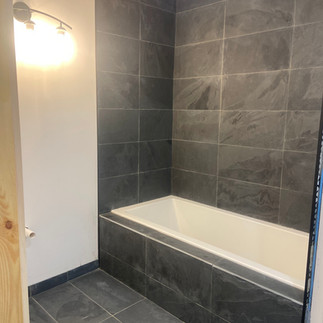Exploring Ecopsychology: Eco-construction
- Justine Ferland
- Apr 11, 2022
- 5 min read
Updated: 16 hours ago
Eco-construction
Ecoconstruction is used to describe buildings that are constructed sustainably. This creates a healthier space for not only our home planet, but your family as well. A space created with intention and purpose of bettering the self and the whole. In this post we will explore the concept and practice of eco-construction with our real life project of renovating the 50 year old barn at our 215 year old farmstead!
Ecopsychology in practice: Eco-construction. Real life process of the transformation and renovation of the Barnhof.
Transformation and addition of 50 year old Barnhof at our 215 year old farmhouse
In accordance with our ethos, and practice of living our beliefs, we set out to create a local, sustainable, and environmentally friendly project from start to finish!
What is ecoconstruction?
Ecoconstruction is used to describe buildings that are constructed sustainably. This creates a healthier space for not only our home planet, but your family as well. A space created with intention and purpose of bettering the self and the whole.Construction materials are one of the most important contributors to green construction and sustainable architecture, as they comprise a large proportion of the building. In addition, Eco-construction may incorporate recycled or reclaimed materials like wood, glass, metal, and concrete in the design phase.
Environmental impact studies will often be performed on eco-friendly buildings before development. This can take the form in energy surveys, land surveys looking for watershed areas or protected species and more. Eco-construction uses materials that are non-toxic, recyclable, and renewable. These materials include soybeans, hemp, bamboo, straw bales, or cork (materials that are fire retardants). Unfortunately, many buildings in the United States harm the environment because of their energy use.
The Eco-construction process: background and community
Eco-construction: building the Barnhof
Eco-construction: Sustainable practices- setting a green intention
The Eco-construction process: background and community
Celebrating our American-German culture, we named the project the Barnhof- a fun play on the German word for farm: Bauernhof.
We tapped into our neighbor's and local community’s rich skill sets and network of resources to keep as much of the project local as possible. Coinciding with the pandemic, we were able to keep everyone safe, in work, and creatively processing throughout. In a time where many were struggling with lack of connection, we were able to further develop our vast ties to our local community.
Why is community involvement important to us? According to the World Health Organization, social connection is one of the four main dimensions of health, along with physical, mental and spiritual (want more info on the four dimensions of health? Check out our detailed post here).

Social health means involvement with community, connection within family and friends, cultivating empathy, compassion and generosity.
We at SEELEDU work holistically with the human condition targeting all four dimensions of health. We celebrate developing our social health through getting involved locally, and fostering relationships with loved ones and nature.
Let's take a look at the first steps in the building process!
Eco-construction: building the Barnhof
With any good project, there are plans, permits, and pondering.
Our small community of barely 1,000 people required building permits with 2 items: an energy audit and a septic system which included a state approved septic design. A septic system engineer, a cousin within our family, surveyed and measured the slope of the land, and tested the soil to determine where to place the septic system. Once it was installed, licensed inspectors had to verify every aspect of the plan was properly executed. The energy audit included step by step math formulas to complete the process by the homeowner, and we also had our local university come survey the property for solar power; unfortunately, we face the wrong direction, with uncooperative weather patterns to capitalize on solar.

Team Barnhof: Lynda, Ryan Willey, & David Ferland
Our neighbor, local forest manager, logging and forest sustainability expert and experienced homesteader, Ryan Willey began systematically clearing the forest based on the health of trees, grade of the land, future use plans (not just for this generation, but for subsequent generations!) and wildlife habitat. Much of the forest that was cleared became the current beams, floor, and other wooden material in the Barnhof. This wood was milled locally within our mountain community through Torsey Farms. Remaining wood became our firewood or was sent to the local processing mill for other projects.
All local to our own mountain community, excavators, skidders, cherry pickers and dump trucks then transformed a 20%graded sloped thick forest, making way for a clearing to dig 410 feet of trenches for underground water, sewer, cable and electricity. At one point the tires of the skidder were in mud 4 feet deep.
The creative and overall design, was a complete collaboration within our family. Our local experienced builders Ron Beauchesne and Chuck Connors were able to take our concepts and design plans and spearhead the project alongside our direct work in the construction process. Our family was directly involved in every aspect of the construction and creation of the Barnhof, logging over 10,000 man hours!
Eco-construction: Sustainable Practices- setting a green intention
In accordance with our beliefs of sustainability- 95% of the wood, doors, windows, insulation, lights, and wires from the demolition process were repurposed and reused here on our property. Additionally, all "new" furniture was rescued, refurbished and repurposed. We wanted to help give old furniture a new life and not see the land fill.
The old barn was built with 2 x 4 construction which would not allow enough insulation to meet the energy audit requirements with typical batten insulation. Super-efficient Spray foam insulation was the solution for the exterior old barn walls. To achieve the requirements of the energy audit several types of insulation had to be used on the project. Wiring in this section of the Barnhof had to be forward thinking, as it is difficult to run wires after spray foam is done, it requires removing walls. Our electrician, local community member Bill Wentzel exceeded expectations with his experience and expertise.
Plumber and local community member Corey Huckins guided us out of a potential issue with freezing pipes because of a bathroom design. Easy fix by rearranging the fixtures before walls and pipes were installed. Energy efficient windows, insulation, high efficiency fireplace, heat and hot water system, and energy efficient appliances contribute to an eco-friendly living space blended with our historic 216-year-old farmhouse named SchaeFerland.
We kept the project in our family with over 10,000 man hours in every aspect of the Barnhof. From left to right: self tiled bathroom; staining wood floor boards with locally milled wood; cousin and eqpd gear founder and designer, Jonathan Baker gets involved in the build on his visit home
Like any good homestead and farm, projects are ongoing! We will check-in and highlight various undertakings, projects and news at SchaeFerland and the Barnhof to highlight our daily work in ecopsychology.
What is Ecopsychology?
Ecopsychology at its core, is about the connection between humankind and nature. It is the bridge between both ecology and psychology. Ecopsychology looks at the person as a whole and the healing properties of nature (such as ecotherapy, green practices, green mindfulness etc.), and also goes beyond individual healing to encompass a broad cultural scope. Ecopsychology looks to redefine and re-imagine society’s current relationship with nature, asking participants to critically think about their interactions with nature, implications of consumerism, materialism, and environmental exploitation. Ecopsychology understands that the needs of the planet are the needs of the person, and the rights of the person are the rights of the planet.
What is SEELEDU and what can SEELEDU do for you?
SEELEDU explores the journey of being human and nurtures nature connections for health and well-being.
This post was a collaboration between SEELEDU founder Justine Ferland and guest contributor Lynda Cadieux-Ferland. Lynda is a homesteader and one half of the visionary team of SchaeFerland and the Barnhof. She is passionate about organic gardening with over 40 years of experience, local community involvement, sustainable practices, and farm to soul food.

































Comments